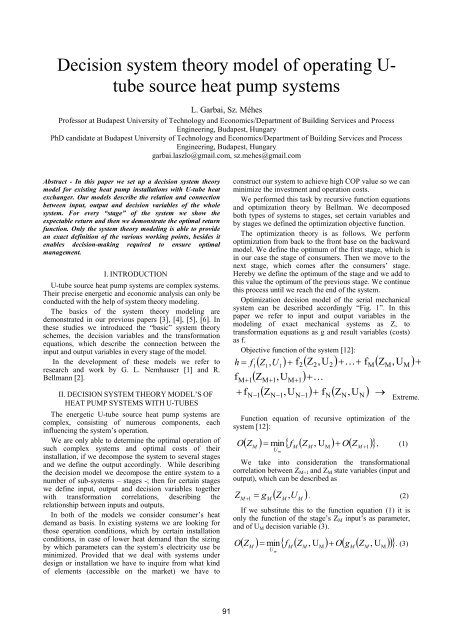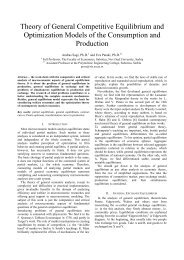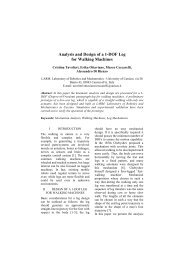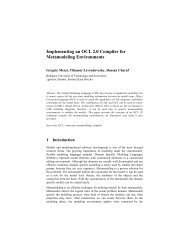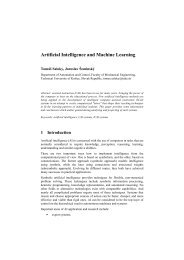Final Program EXPRES 2012 - Conferences
Final Program EXPRES 2012 - Conferences
Final Program EXPRES 2012 - Conferences
- No tags were found...
Create successful ePaper yourself
Turn your PDF publications into a flip-book with our unique Google optimized e-Paper software.
Decision system theory model of operating U-tube source heat pump systemsL. Garbai, Sz. MéhesProfessor at Budapest University of Technology and Economics/Department of Building Services and ProcessEngineering, Budapest, HungaryPhD candidate at Budapest University of Technology and Economics/Department of Building Services and ProcessEngineering, Budapest, Hungarygarbai.laszlo@gmail.com, sz.mehes@gmail.comAbstract - In this paper we set up a decision system theorymodel for existing heat pump installations with U-tube heatexchanger. Our models describe the relation and connectionbetween input, output and decision variables of the wholesystem. For every “stage” of the system we show theexpectable return and then we demonstrate the optimal returnfunction. Only the system theory modeling is able to providean exact definition of the various working points, besides itenables decision-making required to ensure optimalmanagement.I. INTRODUCTIONU-tube source heat pump systems are complex systems.Their precise energetic and economic analysis can only beconducted with the help of system theory modeling.The basics of the system theory modeling aredemonstrated in our previous papers [3], [4], [5], [6]. Inthese studies we introduced the “basic” system theoryschemes, the decision variables and the transformationequations, which describe the connection between theinput and output variables in every stage of the model.In the development of these models we refer toresearch and work by G. L. Nemhauser [1] and R.Bellmann [2].II. DECISION SYSTEM THEORY MODEL’S OFHEAT PUMP SYSTEMS WITH U-TUBESThe energetic U-tube source heat pump systems arecomplex, consisting of numerous components, eachinfluencing the system’s operation.We are only able to determine the optimal operation ofsuch complex systems and optimal costs of theirinstallation, if we decompose the system to several stagesand we define the output accordingly. While describingthe decision model we decompose the entire system to anumber of sub-systems – stages -; then for certain stageswe define input, output and decision variables togetherwith transformation correlations, describing therelationship between inputs and outputs.In both of the models we consider consumer’s heatdemand as basis. In existing systems we are looking forthose operation conditions, which by certain installationconditions, in case of lower heat demand than the sizingby which parameters can the system’s electricity use beminimized. Provided that we deal with systems underdesign or installation we have to inquire from what kindof elements (accessible on the market) we have toconstruct our system to achieve high COP value so we canminimize the investment and operation costs.We performed this task by recursive function equationsand optimization theory by Bellman. We decomposedboth types of systems to stages, set certain variables andby stages we defined the optimization objective function.The optimization theory is as follows. We performoptimization from back to the front base on the backwardmodel. We define the optimum of the first stage, which isin our case the stage of consumers. Then we move to thenext stage, which comes after the consumers’ stage.Hereby we define the optimum of the stage and we add tothis value the optimum of the previous stage. We continuethis process until we reach the end of the system.Optimization decision model of the serial mechanicalsystem can be described accordingly “Fig. 1”. In thispaper we refer to input and output variables in themodeling of exact mechanical systems as Z, totransformation equations as g and result variables (costs)as f.Objective function of the system [12]:h f Z 2Z2,U2fMZM,UMf1 1,U1M1M1M1f Z, Uf Z, U f Z,U N1N1N1N N N Extreme.Function equation of recursive optimization of thesystem [12]: min fZ, OZO ZMUmMMU MM 1, (1)We take into consideration the transformationalcorrelation between Z M+1 and Z M state variables (input andoutput), which can be described asZ ,M 1 gMZMUM. (2)If we substitute this to the function equation (1) it isonly the function of the stage’s Z M input’s as parameter,and of U M decision variable (3). minf Z, U OgZ, O ZM . (3)UmMMM M MU M91


